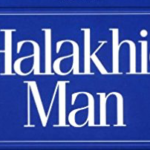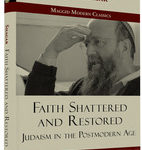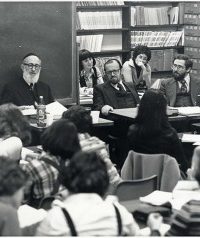In the newly published Toras HoRav volume titled Halakhic Morality, Rabbi Soloveitchik distinguishes between two aspects of Jewish life: a derekh ha-hayyim and signon ha-hayyim. The derekh ha-hayyim, way of life, is universal. As signified by the Shulhan Arukh, each Jew needs to follow the basic path of halakha. There are no exceptions. However, the signon ha-hayyim, style of religious life, provides the opportunity for an individual to imprint their own style onto their avodat Hashem. The Rav writes, “There is in Judaism a universal, impersonal aspect as well as an individual, personal aspect. Judaism is, on the one hand, an objective discipline. The Shulhan Arukh is a book of an institutionalized, organized, fixed, statutory religion. On the other hand, Judaism is also an adventure, a great romance, a heart-warming and ecstatic experience. How to execute the law belongs under the category of derekh. But how to enjoy observance and to reach out for the Eternal belongs not under the category of derekh, but of that of signon, style. There is one derekh, but there is a variety of styles. Each individual interprets his own performance in a unique, singular way.” While our inaugural symposium features a discussion directly related to the Rav’s words (the role of emotion in mitzvah observance), I believe the Rav’s distinction also provides us with a compelling framework for introducing this issue’s theme: Derekh ha-limmud. Derekh ha-limmud provides the opportunity for a signon ha-hayyim. While everyone should be learning Torah, there are a variety of legitimate ways one can go about their study. As Rabbi J.J. Schacter has argued, Judaism does not require us to check our individuality at the door, and methodology of Torah study is certainly an excellent example of such. In this vein, this issue contains articles relating to the methodology of Torah study. Rabbi Netanel Wiederblank writes about the study of mahshava. Miriam Zami explores the potential benefits and challenges of integrating Biblical scholarship into Tanakh education. Leah Klahr presents the Midrash’s use of intertextuality, and Jared Rutner examines the Mishna Berurah’s use of Kabbalistic sources. Furthermore, we are excited to introduce two new sections to Kol Hamevaser: a symposium and a section revisiting classical essays. Finally, Matt Lubin reviews a newly published book by Rav Shagar. We hope you enjoy reading this issue, and we look forward to reading any comments, suggestions, or thoughts you have at [email protected].






Letter from the Editor
In the newly published Toras HoRav volume titled Halakhic Morality, Rabbi Soloveitchik distinguishes between two aspects of Jewish life: a derekh ha-hayyim and signon ha-hayyim. The derekh ha-hayyim, way of life, is universal. As signified by the Shulhan Arukh, each Jew needs to follow the basic path of halakha. There are no exceptions. However, the signon ha-hayyim, style of religious life, provides the opportunity for an individual to imprint their own style onto their avodat Hashem. The Rav writes, “There is in Judaism a universal, impersonal aspect as well as an individual, personal aspect. Judaism is, on the one hand, an objective discipline. The Shulhan Arukh is a book of an institutionalized, organized, fixed, statutory religion. On the other hand, Judaism is also an adventure, a great romance, a heart-warming and ecstatic experience. How to execute the law belongs under the category of derekh. But how to enjoy observance and to reach out for the Eternal belongs not under the category of derekh, but of that of signon, style. There is one derekh, but there is a variety of styles. Each individual interprets his own performance in a unique, singular way.” While our inaugural symposium features a discussion directly related to the Rav’s words (the role of emotion in mitzvah observance), I believe the Rav’s distinction also provides us with a compelling framework for introducing this issue’s theme: Derekh ha-limmud. Derekh ha-limmud provides the opportunity for a signon ha-hayyim. While everyone should be learning Torah, there are a variety of legitimate ways one can go about their study. As Rabbi J.J. Schacter has argued, Judaism does not require us to check our individuality at the door, and methodology of Torah study is certainly an excellent example of such. In this vein, this issue contains articles relating to the methodology of Torah study. Rabbi Netanel Wiederblank writes about the study of mahshava. Miriam Zami explores the potential benefits and challenges of integrating Biblical scholarship into Tanakh education. Leah Klahr presents the Midrash’s use of intertextuality, and Jared Rutner examines the Mishna Berurah’s use of Kabbalistic sources. Furthermore, we are excited to introduce two new sections to Kol Hamevaser: a symposium and a section revisiting classical essays. Finally, Matt Lubin reviews a newly published book by Rav Shagar. We hope you enjoy reading this issue, and we look forward to reading any comments, suggestions, or thoughts you have at [email protected].